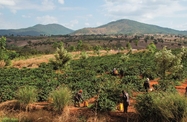National efforts to modernise Tanzania’s underdeveloped agricultural industry received a major boost at the end of 2016, in the form of a $93.5m loan from the African Development Bank.

The funding, which was approved in December, will support the state-owned Tanzania Agricultural Development Bank (TADB) in reaching its target of issuing loans to 1m farmers in the five-year period up to and including 2020 at rates of between 7% and 12%.
Created by the government in 2015, the TABD aims to mobilise financial resources and bolster support across the agricultural sector by making low-interest loans available to small-scale farmers.
Reducing credit risk
The TABD is far from the only financial institution looking to improve funding for the country’s agricultural industry, which accounts for roughly a quarter of total GDP.
Also in December Tanzania’s Private Agricultural Sector Support (PASS) signed an agreement with the Nairobi-based African Guarantee Fund (AGF) to share the risks of loan guarantees for eligible Tanzanian clients.
PASS is a non-banking financial institution that provides small and medium-sized enterprises (SMEs) in the sector with credit facilities, while the AGF offers partial coverage for risks associated with SME financing.
The local body had expected to reach 345,000 entrepreneurs with guaranteed loans totalling TZS114bn ($51.4m) in 2016, and the recent deal with the AGF should facilitate an increase in guaranteed credit approvals this year.
Modernisation drive
Despite providing jobs for approximately 67% of the national workforce, years of underfunding have left Tanzania’s agricultural sector in need of a major overhaul.
Improving storage facilities is high on the list of priorities for the industry. According to government data, up to 42% of produce is lost to pests while in storage. A lack of refrigeration and problems in gaining access to key markets can sometimes mean the percentage is even higher.
As a result, the Ministry of Agriculture, Livestock and Fisheries Development is holding talks with two domestic commercial lenders, the National Microfinance Bank and CRBD Bank, as well as a Kenya-based institute, Commercial Bank of Africa, to secure funds of up to TZS1.5trn ($676.5m) to improve the industry’s post-harvest infrastructure.
Long-term plans gain momentum
The national drive to improve agricultural output forms part of a broader bid by the government to transform Tanzania into a middle-income country by 2025.
The country has devised three five-year development plans to help it achieve its goals. The first initiative, which ran from 2011 to 2016, identified five priority areas for development, with targets that included making the agricultural sector more export-driven and improving self-sufficiency.
Running from 2016 to 2020, the second plan has the development of agro-industries and agro-processing as a key focus, in line with broader efforts to boost industrialisation and increase sectoral growth to 7.6%. The initiative also targets raising the sector’s contribution to the economy from 25% of GDP through greater use of modern technologies, ICT training and knowledge transfer.
The authorities hope that their efforts will boost productivity, develop value chains, improve infrastructure and broaden access to financial services.
Under the current initiative, the Ministry of Finance and Planning also announced plans to establish leather industries, food processing and production centres, and sisal processing facilities in several of the country’s key agricultural centres.
Tackling the challenges
The government’s efforts have not been challenge-free, with the industry failing to meet a growth target of 6-8% by 2015 that was laid out in the first five-year plan. According to a government progress report, agricultural growth had reached just 2.3% by the end of 2015, down from 2.7% in 2010. The Ministry of Finance and Planning attributed the disappointing performance to slowed productivity and lack of irrigation. Only 30% of cultivated land in Tanzania is currently irrigated, according to government data.
However, efforts to boost downstream processing have borne more fruit, with value-added net output rising by 61% between 2009 and 2014 to reach $13.8bn, around 5% higher than the regional average.
The positive figures highlight the potential for growth in value-added products, such as coffee, cotton, sisal products and wheat flour. They will also encourage the authorities to keep the focus on support for Tanzania’s agricultural entrepreneurs and small-scale farmers.


